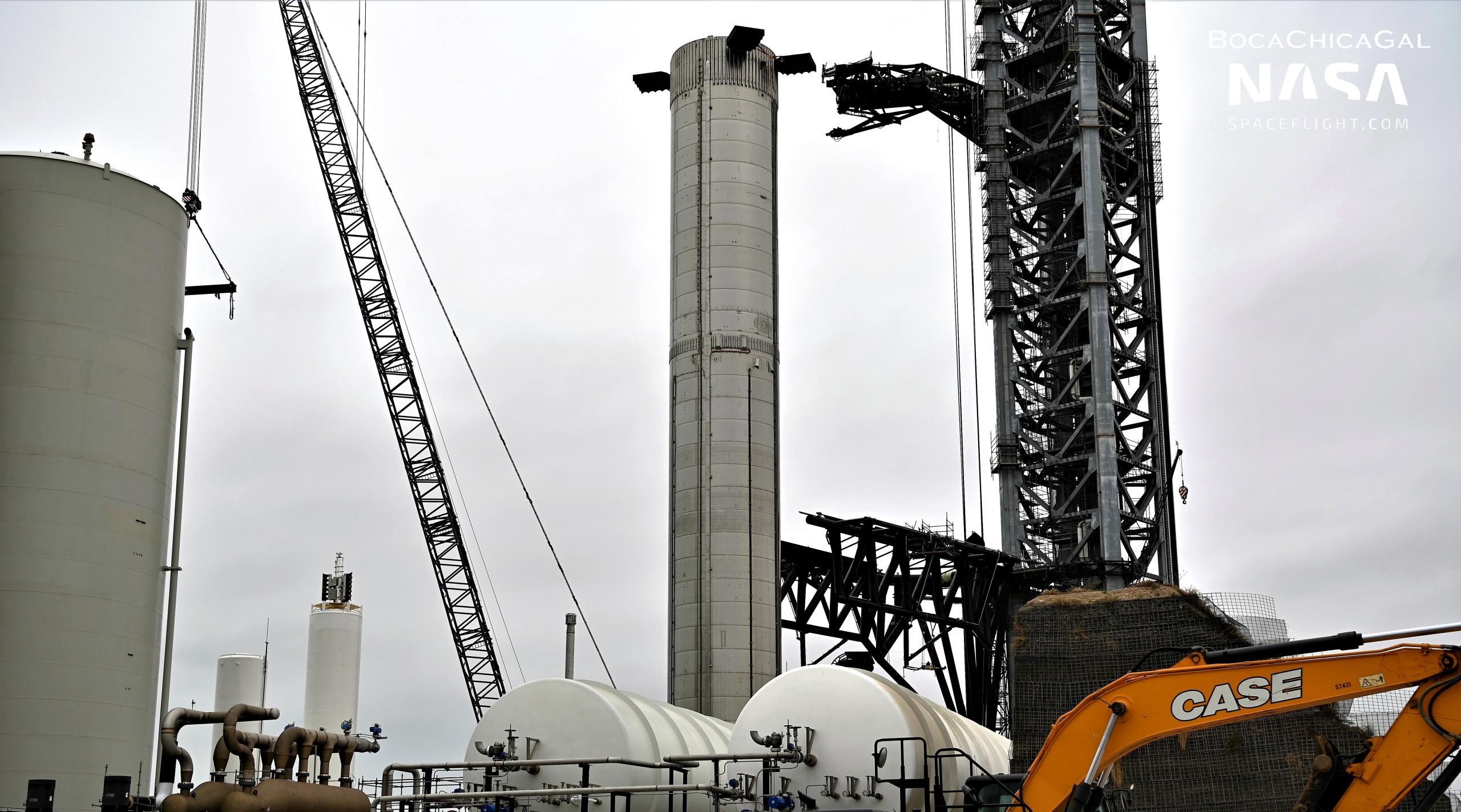
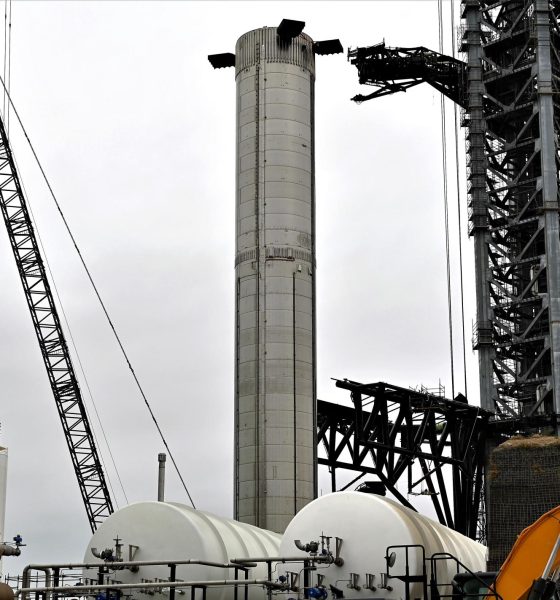
News
SpaceX rolls Super Heavy booster to orbital launch mount
For the third time in four months, SpaceX has rolled the first potentially flightworthy Super Heavy booster towards Starbase’s orbital launch mount.
Combined with a large crane – fitted with a jig solely used to lift boosters – moving to a spot just beside the booster, it’s clear that SpaceX is preparing to reinstall Super Heavy Booster 4 (B4) on the orbital launch mount. In the context of its unusual history, though, what happens next to the first more or less finished prototype of the largest rocket booster ever built is less clear.
After a shockingly quick assembly over the course of six summer weeks, Super Heavy Booster 4 rolled out of Starbase’s ‘high bay’ facility and headed to the nearby orbital launch complex, where it was installed on a custom ‘mount’ designed to support booster testing and orbital launches. It’s now clear that during that early August photo opportunity and fit test, Booster 4 was nowhere close to finished. Nor, apparently, was it anywhere close to complete one month later when it returned to the orbital pad for the second time after another few weeks of work back at the high bay.
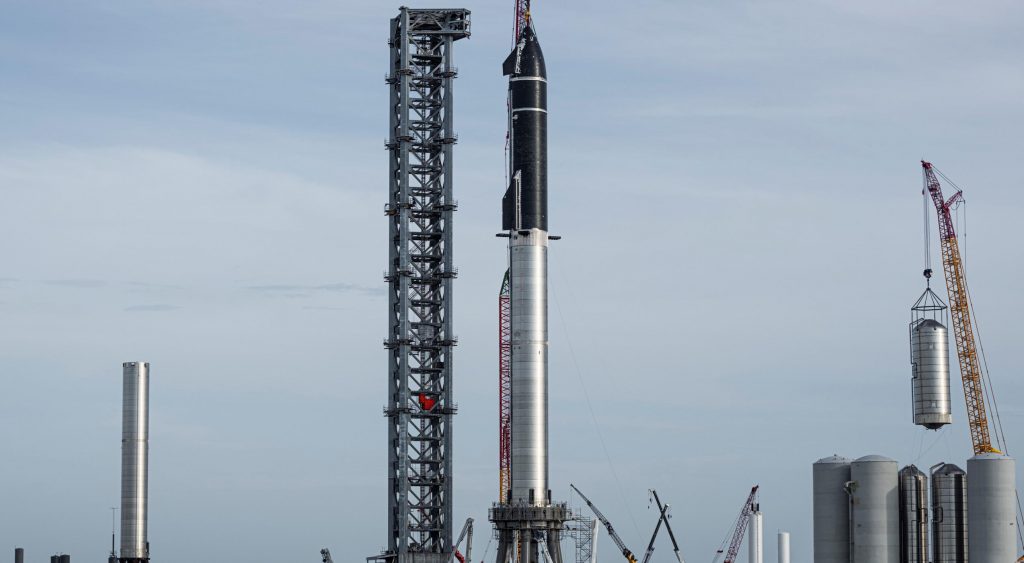
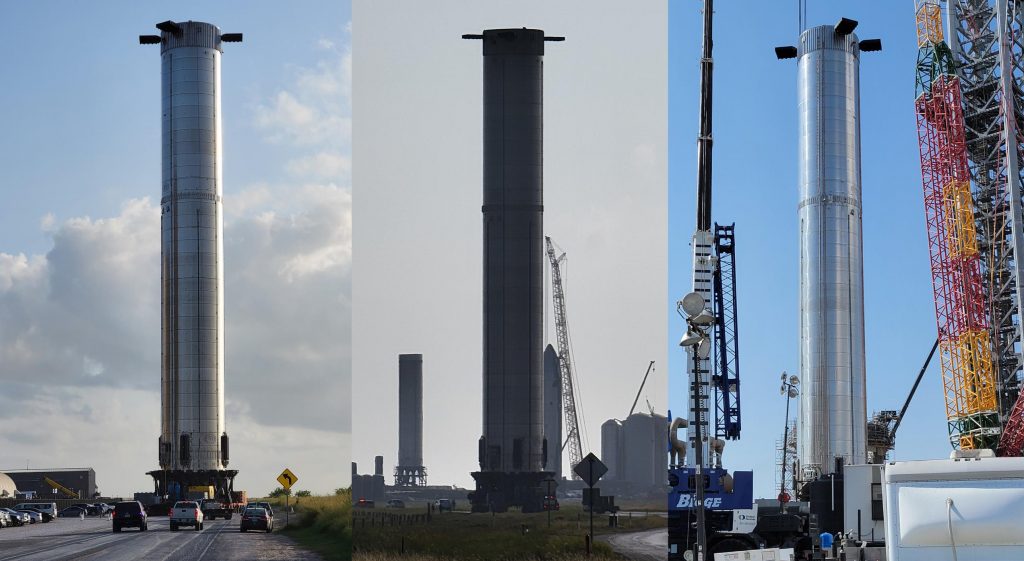
Three months (almost 14 weeks or 100 days) after the Super Heavy prototype’s second trip to the pad, SpaceX has yet to attempt to put the booster through a single proof test. There also appears to be a significant amount of work left to finish installing external ‘aerocovers’ and a heat shield meant to enclose all 29 of its Raptor engines. In the three-year history of Starbase, there isn’t a single prototype of the roughly two-dozen SpaceX has built, tested, and even flown that’s spent even half as long as Super Heavy B4 between apparent structural completion and its first test. Perhaps the fact that Booster 4 is a first-of-its-kind pathfinder explains SpaceX’s uncharacteristic sluggishness or reluctance to actually test the rocket.
In every other instance, SpaceX’s approach to Starship development has been to move incredibly quickly, build a large number of prototypes, and rapidly test those prototypes – often resulting in catastrophic failures. Data is gathered from those failures (SN1, SN3, SN4, SN8, SN9, SN10, SN11, and half a dozen smaller test tanks serve as examples), changes are made, and then the new and improved prototypes that follow repeat the process until SpaceX arrives at a successful design.
Super Heavy B4’s circuitous path has been almost nothing like those of its predecessors. That could also be partly explained by the unavailability of a stand or facilities capable of truly proof testing a Super Heavy, which necessitates a supply of around 3200 tons (7M lb) of liquid nitrogen (LN2; for a cryogenic proof test with full tanks), another 3200 tons of a combination of liquid methane (LCH4) and oxygen (LOx), and the ability to ignite – and survive – as many as 29 to 33 Raptor engines. The suborbital stands SpaceX has used to proof Starships and even Super Heavy Booster 3 don’t even have half the storage capacity required to fully test a booster and the mounts and their surroundings would likely be catastrophically damaged or destroyed by the thrust and blast created by dozens of Raptors.
Still, SpaceX could have theoretically put Booster 4 through a partial cryoproof and maybe fired up as many as nine Raptors at once – not a replacement for full proof testing but still plenty to ensure Super Heavy’s structural integrity and gather invaluable data on clustered Raptor performance. Instead, of course, Super Heavy B4 has sat at Starbase’s former landing zone for more than three months while teams removed engines, reinstalled engines, half-installed a full Raptor heat shield; and installed two of six or seven ‘aerocovers’ needed to protect heat exchangers, racks of pressure vessels, and hydraulic systems installed on the booster’s aft.
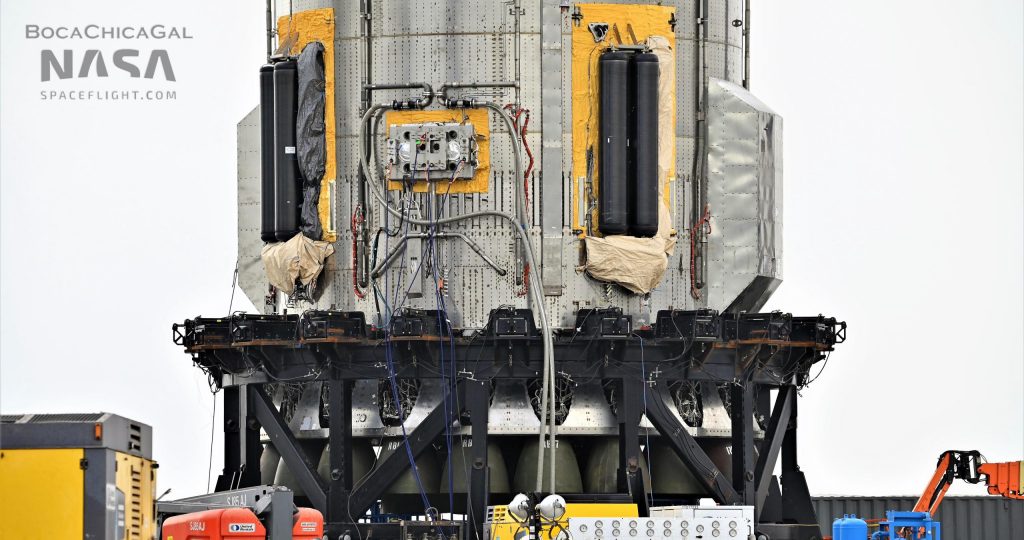
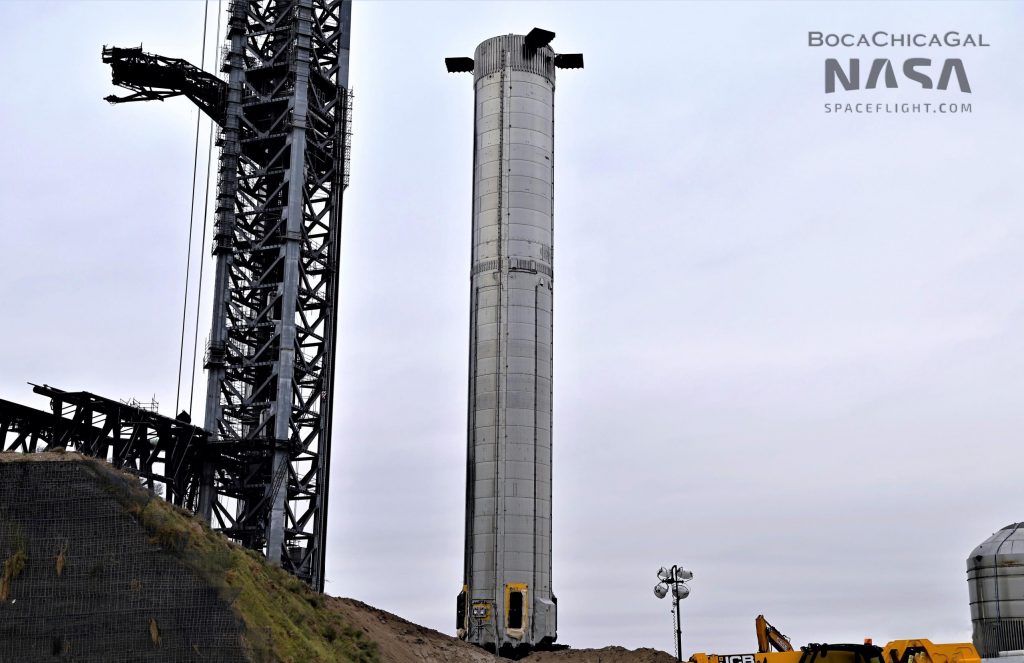
This is all to say that from the outside looking in, Booster 4’s path towards testing and flight has been almost entirely different from that of any other Starship prototype. While still quick in comparison with other launch vehicle development programs, relative to other Starship and Super Heavy prototypes, the rate of B4 progress has been far slower – strongly implying that something is seriously wrong with the booster, that SpaceX no longer feels that partial testing is worth the effort, that finishing Booster 4 just hasn’t been a priority for several months, or some combination of the above.
What that ultimately means is that it’s almost impossible to predict what Super Heavy B4’s future holds beyond the clear evidence that SpaceX will soon reinstall to reinstall it on an orbital launch mount that’s much closer to completion than it was the last time B4 was installed. At this point, it’s just as likely that the booster’s third launch mount installation will just be another mechanical fit test, though the hope is that it will kick off full-scale pneumatic and cryogenic proof testing. It could even culminate in the static fire of some or all of its 29 Raptor engines, which have been installed for several months.

Elon Musk
Elon Musk and Tesla AI Director share insights after empty driver seat Robotaxi rides
The executives’ unoccupied tests hint at the rapid progress of Tesla’s unsupervised Robotaxi efforts.

Tesla CEO Elon Musk and AI Director Ashok Elluswamy celebrated Christmas Eve by sharing personal experiences with Robotaxi vehicles that had no safety monitor or occupant in the driver’s seat. Musk described the system’s “perfect driving” around Austin, while Elluswamy posted video from the back seat, calling it “an amazing experience.”
The executives’ unoccupied tests hint at the rapid progress of Tesla’s unsupervised Robotaxi efforts.
Elon and Ashok’s firsthand Robotaxi insights
Prior to Musk and the Tesla AI Director’s posts, sightings of unmanned Teslas navigating public roads were widely shared on social media. One such vehicle was spotted in Austin, Texas, which Elon Musk acknowleged by stating that “Testing is underway with no occupants in the car.”
Based on his Christmas Eve post, Musk seemed to have tested an unmanned Tesla himself. “A Tesla with no safety monitor in the car and me sitting in the passenger seat took me all around Austin on Sunday with perfect driving,” Musk wrote in his post.
Elluswamy responded with a 2-minute video showing himself in the rear of an unmanned Tesla. The video featured the vehicle’s empty front seats, as well as its smooth handling through real-world traffic. He captioned his video with the words, “It’s an amazing experience!”
Towards Unsupervised operations
During an xAI Hackathon earlier this month, Elon Musk mentioned that Tesla owed be removing Safety Monitors from its Robotaxis in Austin in just three weeks. “Unsupervised is pretty much solved at this point. So there will be Tesla Robotaxis operating in Austin with no one in them. Not even anyone in the passenger seat in about three weeks,” he said. Musk echoed similar estimates at the 2025 Annual Shareholder Meeting and the Q3 2025 earnings call.
Considering the insights that were posted Musk and Elluswamy, it does appear that Tesla is working hard towards operating its Robotaxis with no safety monitors. This is quite impressive considering that the service was launched just earlier this year.
Elon Musk
Starlink passes 9 million active customers just weeks after hitting 8 million
The milestone highlights the accelerating growth of Starlink, which has now been adding over 20,000 new users per day.

SpaceX’s Starlink satellite internet service has continued its rapid global expansion, surpassing 9 million active customers just weeks after crossing the 8 million mark.
The milestone highlights the accelerating growth of Starlink, which has now been adding over 20,000 new users per day.
9 million customers
In a post on X, SpaceX stated that Starlink now serves over 9 million active users across 155 countries, territories, and markets. The company reached 8 million customers in early November, meaning it added roughly 1 million subscribers in under seven weeks, or about 21,275 new users on average per day.
“Starlink is connecting more than 9M active customers with high-speed internet across 155 countries, territories, and many other markets,” Starlink wrote in a post on its official X account. SpaceX President Gwynne Shotwell also celebrated the milestone on X. “A huge thank you to all of our customers and congrats to the Starlink team for such an incredible product,” she wrote.
That growth rate reflects both rising demand for broadband in underserved regions and Starlink’s expanding satellite constellation, which now includes more than 9,000 low-Earth-orbit satellites designed to deliver high-speed, low-latency internet worldwide.
Starlink’s momentum
Starlink’s momentum has been building up. SpaceX reported 4.6 million Starlink customers in December 2024, followed by 7 million by August 2025, and 8 million customers in November. Independent data also suggests Starlink usage is rising sharply, with Cloudflare reporting that global web traffic from Starlink users more than doubled in 2025, as noted in an Insider report.
Starlink’s momentum is increasingly tied to SpaceX’s broader financial outlook. Elon Musk has said the satellite network is “by far” the company’s largest revenue driver, and reports suggest SpaceX may be positioning itself for an initial public offering as soon as next year, with valuations estimated as high as $1.5 trillion. Musk has also suggested in the past that Starlink could have its own IPO in the future.
News
NVIDIA Director of Robotics: Tesla FSD v14 is the first AI to pass the “Physical Turing Test”
After testing FSD v14, Fan stated that his experience with FSD felt magical at first, but it soon started to feel like a routine.

NVIDIA Director of Robotics Jim Fan has praised Tesla’s Full Self-Driving (Supervised) v14 as the first AI to pass what he described as a “Physical Turing Test.”
After testing FSD v14, Fan stated that his experience with FSD felt magical at first, but it soon started to feel like a routine. And just like smartphones today, removing it now would “actively hurt.”
Jim Fan’s hands-on FSD v14 impressions
Fan, a leading researcher in embodied AI who is currently solving Physical AI at NVIDIA and spearheading the company’s Project GR00T initiative, noted that he actually was late to the Tesla game. He was, however, one of the first to try out FSD v14.
“I was very late to own a Tesla but among the earliest to try out FSD v14. It’s perhaps the first time I experience an AI that passes the Physical Turing Test: after a long day at work, you press a button, lay back, and couldn’t tell if a neural net or a human drove you home,” Fan wrote in a post on X.
Fan added: “Despite knowing exactly how robot learning works, I still find it magical watching the steering wheel turn by itself. First it feels surreal, next it becomes routine. Then, like the smartphone, taking it away actively hurts. This is how humanity gets rewired and glued to god-like technologies.”
The Physical Turing Test
The original Turing Test was conceived by Alan Turing in 1950, and it was aimed at determining if a machine could exhibit behavior that is equivalent to or indistinguishable from a human. By focusing on text-based conversations, the original Turing Test set a high bar for natural language processing and machine learning.
This test has been passed by today’s large language models. However, the capability to converse in a humanlike manner is a completely different challenge from performing real-world problem-solving or physical interactions. Thus, Fan introduced the Physical Turing Test, which challenges AI systems to demonstrate intelligence through physical actions.
Based on Fan’s comments, Tesla has demonstrated these intelligent physical actions with FSD v14. Elon Musk agreed with the NVIDIA executive, stating in a post on X that with FSD v14, “you can sense the sentience maturing.” Musk also praised Tesla AI, calling it the best “real-world AI” today.








